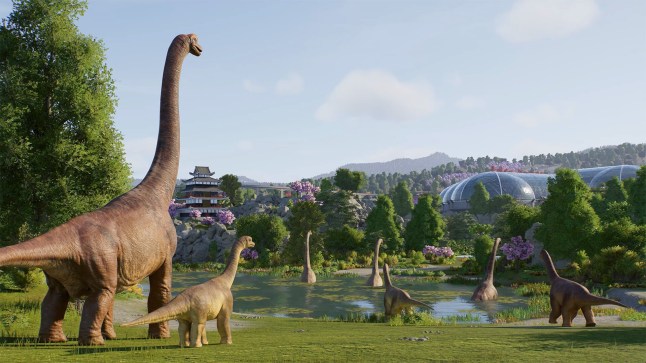Frontier Developments is the undisputed master of the construction and management simulation genre in the industry at this point (and has been for quite some time), and alongside the likes of Planet Zoo and Planet Coaster, the Jurassic World Evolution series has been a big part of how the studio has solidified that reputation in its more recent history. The first two games in the dinosaur theme park management franchise were both excellent experiences that not only served as wonderful love letters to the beloved franchises they were based on, but also as shining examples of just how compelling a well made management sim can be.
Now, four years on from the launch of the series’ sophomore outing, Jurassic World Evolution 3 arrives on the scene, promising yet more iterative improvements and expansions on an established and successful formula. The end result, to little surprise, is a fantastic, addictive, authentic (when it needs to be), and riotously enjoyable game that, in spite of ultimately being only an iterative improvement on its predecessor’s mechanical foundation, still ends up feeling like an unmissable experience for fans of the genre and the franchise.
“The biggest of Jurassic World Evolution 3’s additions to the series’ gameplay foundation is juvenile dinosaurs.”
If you’ve played the previous Jurassic World Evolution games (or, really, any game that fits the mould of the classic construction and management sim), you’re going to have a good idea of what to expect going in. Jurassic World Evolution 3 puts players in charge of building, managing, and expanding their own dinosaur theme park, building enclosures; genetically creating, modifying, and looking after dinos; looking at guests and their satisfaction levels and building a variety of amenities and park improvements in response; managing park finances and taking on different kinds of contracts; and more.
It’s the Zoo Tycoon and RollerCoaster Tycoon formula adapted and altered to fit with the Jurassic Park/World franchise, same as the first two Jurassic World Evolution games- only this time, a number of relatively smaller improvements come together to offer what might be the most polished and easily enjoyable version of this already winning formula.
The biggest of Jurassic World Evolution 3’s additions to the series’ gameplay foundation is juvenile dinosaurs. Yes, that’s right- you’ll now get to see baby, miniaturized versions of all manner of dinosaur species that will then grow and thrive over time (assuming, of course, that you’re ensuring that they do), from adorable small-sized Lokiceratops to smaller, not-quite-mature versions of even the most vicious and ferocious looking creatures in the game’s expansive roster.

“Keeping an eye on those very dino numbers and ensuring that things don’t get too chaotic, is a big part of the core loop in Jurassic World Evolution 3.“
That goes hand in hand with the introduction of dinosaur breeding. Players are now asked to pay attention to (and modulate according to their needs) the gender of each dinosaur in your park, because dinosaurs can and will now procreate. Though you will, of course, still be sending out expedition teams to bring back fossils that you can then use to modify and artificially birth new dinosaurs of different species, once they’re let loose in enclosures, dinosaurs will often mate and procreate on their own, leaving eggs in nesting sights.
That, in turn, means that your park’s dino population isn’t always going to be in your control- in fact, keeping an eye on those very dino numbers and ensuring that things don’t get too chaotic, too overpopulated, or problematic in any number of other ways, is a big part of the core loop in Jurassic World Evolution 3. It’s an engaging new layer on top of an already compelling web of mechanics.
On top of dinosaur breeding and adorable juvenile dinos, Jurassic World Evolution 3 also boasts a larger, more granular set of building, editing, and customizing tools, affording players greater control over their dinosaur park than the previous two Evolution titles.
Whether it’s through elaborate decorations of all shapes and sizes, the greater freedom you’re afforded in building and shaping dinosaur enclosures around natural environmental fixtures, or the creation and sharing tools baked into the game itself, Jurassic World Evolution 3 seems to prioritize player agency and complete freedom in customization over almost all other aspects of the genre- which, of course, is exactly what you want from a game of this sort.

“Taking players to a variety of maps across the world, Evolution 3’s campaign keeps things consistently fresh and entertaining.”
There are, of course, also several ways to sink your claws into the game’s offerings, with multiple modes on offer. The meat and potatoes here is the campaign, which steps back from the toothier, more fast paced nature of Jurassic World Evolution 2’s campaign (which was still a lot of fun in its own right, personally speaking), and goes back to offering an experience focused on park building and management rather than dealing with a string of disasters of growing scale (though that does still play a part here- this is still Jurassic Park, after all).
Taking players to a variety of maps across the world, Evolution 3’s campaign keeps things consistently fresh and entertaining through well thought out objectives, great maps, and of course, an excellent gameplay foundation. The writing and voice acting are also surprisingly among the campaign’s strengths. This is obviously not a story focused game by any means, as you’d expect from the genre, but the cast of characters that provide voice overs (and missions) throughout the experience are generally quite colourful and interesting in different ways. Unsurprisingly, the star of the show is the legendary Dr. Ian Malcolm, once again voiced by none other than Jeff Goldblum itself, whose constant cynicism and Goldblumisms make for genuine laughs on a constant basis.
Beyond the campaign, there’s the challenge mode, which lets players take on specific scenarios that task you with different missions in locations around the world. Personally, I found the challenge mode way less engaging than the campaign, primarily because my preferred way of playing is to distract myself away from the main objective and spend an obscene amount of time just building up and perfecting a single park. If you want relatively shorter and more directed doses of Jurassic World Evolution 3’s construction and management sim systems, challenge mode is worth looking into- but I just don’t think that that’s where the game shines.

“For fans of the genre, the Evolution games, and the Jurassic Park series as a whole, Jurassic World Evolution 3 is an excellent love letter to all of those things.”
There is, of course, a sandbox mode as well, where you can build the park of your dreams with exactly the ruleset that you want- including, if you prefer, no restrictions whatsoever. Sandbox modes are usually where games of this genre tend to get most of their replayability from, and sure enough, that’s very much the case here as well.
Though the campaign is, as I mentioned, a ton of fun, it’s the enjoyable and highly customizable sandbox mode that makes Jurassic World Evolution 3 as endlessly playable as it is- especially if creating and managing (and potentially causing chaos in) your own dinosaur theme park was a childhood dream you grew up with.
Jurassic World Evolution 3 isn’t a huge step forward, nor does it do anything radically different from its predecessors in a way that would convince those who didn’t like the first two Evolution games to dive into this newest entry. But for fans of the genre, the Evolution games, and the Jurassic Park series as a whole, Jurassic World Evolution 3 is an excellent love letter to all of those things, making it a must buy, just like its predecessors. Once again, Frontier Developments has made sure that life finds a way.
This game was reviewed on PlayStation 5.



